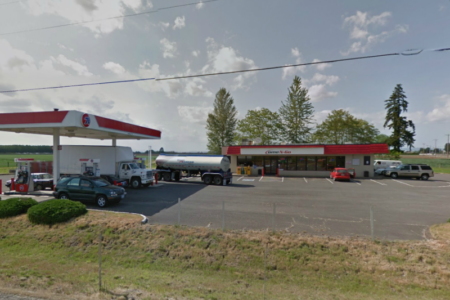
Share On Social!
Woodburn, Oregon, is a small town south of Portland that’s miles away from a full-service supermarket.
The Come N Go corner store, on the outskirts of town, provides hot pre-packaged foods and snacks for on-the-go families and farm workers who stop by on their way to the surrounding fields and farms.
Find out how Elizabeth Montano, a mother with two jobs and the owner of Come N Go, made it her mission to give customers healthier options.
The Issue of Nutrition in the Community
Awareness: Elizabeth Montano had always toyed with the idea of opening her own shop Woodburn, Oregon (63% Latino), and when the security of her full-time job became uncertain, it looked like the time was right.
In April 2012, Montano opened Come N Go, a convenience store that sells pre-packed snacks and drinks, as well as some hot items like soup and burritos that are prepared in-store.
“It’s very stressful, very hard, I’ve never been in this type of environment before,” said Montano, who stays positive even while juggling her old job as well as the new store. “It’s also been rewarding, creating jobs for people in the community, getting to know new people you never knew before.”
Situated right outside of town, many farm workers and families who live nearby have no choice but to grab what’s available at Come N Go on their way to work or school.
Many times, this was fried food, chips, and a sugary soda.
“At four o’clock in the morning… we are the only store open in this area,” Montano said.
The Marion County Health Department had noticed this healthy foods dilemma at local corner stores as well.
“These stores are the only [food] access some of the residents in the community have,” said Emily DeHayr of the health department.

In fall 2011, the department received a grant from Kaiser Permanente Northwest for a Healthy Corner Stores Initiative to help existing corner stores in USDA-identified food deserts around the county introduce and expand healthier food options. A food desert is an area where there is no full-service grocery store within a mile radius and most people living in the area are low-income.
“By increasing…healthy and fresh foods, we are hoping that residents will purchase foods high in nutritional value, thus positively impacting their health,” DeHayr said.
Not yet knowing about the Healthy Corner Stores Initiative, Montano began making healthy changes on her own.
Because customers were asking, she had begun to roll out a few healthier hot food options, like veggie and soy burritos. But she wanted to do more.
Montano not only worried about the health of her customers, but her two children as well.
“Food for us is socialization, is comfort, is friendship,” Montano said. She didn’t want her kids to struggle with their weight as she had.
Deciding to take charge of her family’s health, Montano enrolled herself and her kids in nutrition classes.
Learn: In the classes, Montano and her kids learned about proper portion sizing, limiting fatty foods, and excess sugar. Montano said that she and her kids really enjoyed the classes, and now have a better understanding of what is and isn’t healthy.
“Now they understand what I’m telling them [to eat] and I understand why I’m telling them,” she said.
Frame Issue: It was at these nutrition classes that Montano first learned about the Healthy Corner Stores Initiative.
“I mentioned to the [nutrition educator] that we have a little store and we are trying to change some things,” Montano said.
The nutrition educator urged Montano to contact the health department officials in charge of the Healthy Corner Stores Initiative, who she hoped could help her continue to expand healthy food options at Come N Go.
Developing a Solution for Better Nutrition in the Community
Education/Mobilization: Montano met with health department officials to assess current food offerings at Come N Go and how they could improve.
“The program looks different for every store” so the initiative is tailored to each store based on the store owner and clientele, said Jennifer Eskridge of the health department. Eskridge and Montano both said Latinos make up the majority of regular customers at Come N Go.
To get input from each store’s customers, the health department designed. The survey asked questions about how often people purchase dairy, fresh fruits and vegetables, and low fat snacks; what items they would like the store owner to sell; how likely they are to purchase fresh fruits and vegetables, low sugar drinks, and low fat food if available; if they receive SNAP or WIC; if they believe eating healthy helps maintain body weight; if they believe eating healthy prevents chronic disease such as diabetes, heart disease, stroke; if they use tobacco and what type.
“Based on the surveys [at Come N Go], we determined that the market existed” and people were eager for healthy options, Montano said.
Debate: There were a few barriers that Montano and the health department had to deal with before they could make room for and sell healthier options.
Some staff turnover kept the program from gaining steam right at first, DeHayr said.
“We also had to do some education about what types of products to bring in and what met our healthy nutrition guidelines,” she said. The guidelines are based off of the Institute of Medicine (IOM) and the American Dietetic Association (ADA) healthful eating recommendations and guidelines.
Enacting a Solution for Better Nutrition in the Community
Activation: The Healthy Corner Store Initiative provides all participating stores with marketing and technical assistance, but each store receives other aid depending on their unique needs.
“Come N Go also received a small refrigerator and marketing materials,” DeHayr said.
Frame Policy: The store owners and the health department truly collaborate to ensure that the changes the owners are making are right for the store.
“Based on what is already offered, or an area that is lacking, we develop three store goals,” said DeHayr, “one in each section of stocking healthy foods, marketing, and adhering to store business standards or infrastructure changes.”
For Come N Go, Montano committed to a systems change:
- Increase fresh fruit and vegetable inventory, canned fruit and vegetable options, whole grain breads and snacks, and 100% fruit juice;
- Incorporate marketing of healthy options inside the store (freezer tags, shelf tags, etc.) and outside the store (door decals and roadside signs); and
- Become SNAP & WIC certified.

Source: Marion County Health Department
Change: In April 2013, Montano and her Come N Go corner store operationalized its three-part commitment to increase healthier food options, market those options, and become SNAP/WIC certified.
The store now offers a “healthy corner” to market its wider variety of fresh fruits like mangos and oranges, as well as yogurt, avocados, small boxes of raisins and almonds.
The store also replaced many of the regular fried chips with baked chips.
Sustaining a Solution for Better Nutrition in the Community
Implementation: 5 a.m. is still a busy hour for Come N Go, but now on the way to work or school folks can grab a well-balanced breakfast or lunch and have the option to add some fruit or other healthy snacks.
The fresh-made burritos at Come N Go are still their most popular items, some filled with chicken and rice and some filled just with veggies and homemade beans—all now made with fresh ingredients at the store. Yogurt is also a very popular option.
Oranges and apples are also top sellers.
At first, to ensure profitability and keep fresh produce from spoiling, Montano chose to buy only a few items at a time.
“We started very small,” she said, just picking up a few more bananas, oranges, and mangos.
Then, after a few days, she and her staff would cut up the remaining fruit and put them in cups, which were a huge hit among customers, especially during the hot summer months.
Montano said that never in a million years would she think that little boxes of almonds would sell, but they are. She also is amazed that customers are buying whole avocados to eat as snacks.
Sustainability: Montano advises other corner store owners who want to incorporate healthier options to do it slowly so they don’t get overwhelmed, waste food, or lose money.
“You have to get a feel for what people are buying,” she said. “Go little by little.”
Meanwhile, for the health department’s larger Healthy Corner Stores Initiative, officials have discussed getting youth involved in the corner store makeovers, be it through helping design signage for healthy items, tagging the options, or helping to promote the stores in the neighborhood. Nothing is set in stone yet, but the health department is continuing to brainstorm ways to get youth excited and engaged with healthy options.
Because of all her new nutrition education and new store offerings, Montano says that the future, for her community and for her own children, is looking a whole lot healthier.
Explore More:
Healthy FoodBy The Numbers
1
Supermarket
for every Latino neighborhood, compared to 3 for every non-Latino neighborhood
This success story was produced by Salud America! with support from the Robert Wood Johnson Foundation.
The stories are intended for educational and informative purposes. References to specific policymakers, individuals, schools, policies, or companies have been included solely to advance these purposes and do not constitute an endorsement, sponsorship, or recommendation. Stories are based on and told by real community members and are the opinions and views of the individuals whose stories are told. Organization and activities described were not supported by Salud America! or the Robert Wood Johnson Foundation and do not necessarily represent the views of Salud America! or the Robert Wood Johnson Foundation.



